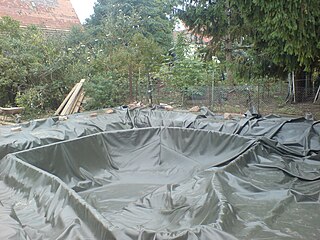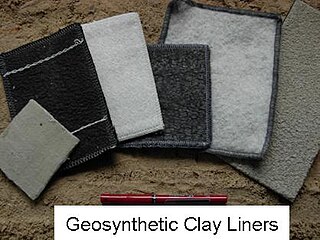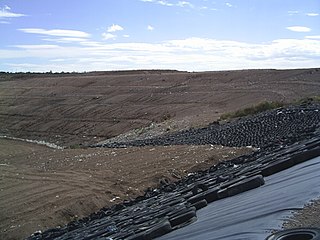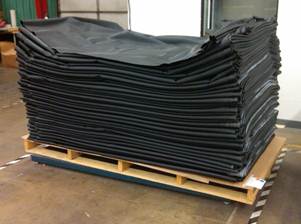
A leachate is any liquid that, in the course of passing through matter, extracts soluble or suspended solids, or any other component of the material through which it has passed.

Geosynthetics are synthetic products used to stabilize terrain. They are generally polymeric products used to solve civil engineering problems. This includes eight main product categories: geotextiles, geogrids, geonets, geomembranes, geosynthetic clay liners, geofoam, geocells and geocomposites. The polymeric nature of the products makes them suitable for use in the ground where high levels of durability are required. They can also be used in exposed applications. Geosynthetics are available in a wide range of forms and materials. These products have a wide range of applications and are currently used in many civil, geotechnical, transportation, geoenvironmental, hydraulic, and private development applications including roads, airfields, railroads, embankments, retaining structures, reservoirs, canals, dams, erosion control, sediment control, landfill liners, landfill covers, mining, aquaculture and agriculture.

High-density polyethylene (HDPE) or polyethylene high-density (PEHD) is a thermoplastic polymer produced from the monomer ethylene. It is sometimes called "alkathene" or "polythene" when used for HDPE pipes. With a high strength-to-density ratio, HDPE is used in the production of plastic bottles, corrosion-resistant piping, geomembranes and plastic lumber. HDPE is commonly recycled, and has the number "2" as its resin identification code.

Waterproofing is the process of making an object or structure waterproof or water-resistant so that it remains relatively unaffected by water or resisting the ingress of water under specified conditions. Such items may be used in wet environments or underwater to specified depths.

Linear low-density polyethylene (LLDPE) is a substantially linear polymer (polyethylene), with significant numbers of short branches, commonly made by copolymerization of ethylene with longer-chain olefins. Linear low-density polyethylene differs structurally from conventional low-density polyethylene (LDPE) because of the absence of long chain branching. The linearity of LLDPE results from the different manufacturing processes of LLDPE and LDPE. In general, LLDPE is produced at lower temperatures and pressures by copolymerization of ethylene and such higher alpha-olefins as butene, hexene, or octene. The copolymerization process produces an LLDPE polymer that has a narrower molecular weight distribution than conventional LDPE and in combination with the linear structure, significantly different rheological properties.

Geotextiles are permeable fabrics which, when used in association with soil, have the ability to separate, filter, reinforce, protect, or drain. Typically made from polypropylene or polyester, geotextile fabrics come in two basic forms: woven and nonwoven.

A pond liner is an impermeable geomembrane used for retention of liquids, including the lining of reservoirs, retention basins, hazardous and nonhazardous surface impoundments, garden ponds and artificial streams in parks and gardens.

Geocomposites are combinations of two or more geosynthetic materials for civil engineering applications that perform multiple geosynthetic functions. Such composite materials enhance technical properties of the soil or the geotechnical structure, while minimizing application costs.

Geosynthetic clay liners (GCLs) are factory manufactured hydraulic barriers consisting of a layer of bentonite or other very low-permeability material supported by geotextiles and/or geomembranes, mechanically held together by needling, stitching, or chemical adhesives. Due to environmental laws, any seepage from landfills must be collected and properly disposed of, otherwise contamination of the surrounding ground water could cause major environmental and/or ecological problems. The lower the hydraulic conductivity the more effective the GCL will be at retaining seepage inside of the landfill. Bentonite composed predominantly (>70%) of montmorillonite or other expansive clays, are preferred and most commonly used in GCLs. A general GCL construction would consist of two layers of geosynthetics stitched together enclosing a layer of natural or processed sodium bentonite. Typically, woven and/or non-woven textile geosynthetics are used, however polyethylene or geomembrane layers or geogrid geotextiles materials have also been incorporated into the design or in place of a textile layer to increase strength. GCLs are produced by several large companies in North America, Europe, and Asia. The United States Environmental Protection Agency currently regulates landfill construction and design in the US through several legislations.

A landfill liner, or composite liner, is intended to be a low permeable barrier, which is laid down under engineered landfill sites. Until it deteriorates, the liner retards migration of leachate, and its toxic constituents, into underlying aquifers or nearby rivers, causing potentially irreversible contamination of the local waterway and its sediments.

Cellular confinement systems (CCS)—also known as geocells—are widely used in construction for erosion control, soil stabilization on flat ground and steep slopes, channel protection, and structural reinforcement for load support and earth retention. Typical cellular confinement systems are geosynthetics made with ultrasonically welded high-density polyethylene (HDPE) strips or novel polymeric alloy (NPA)—and expanded on-site to form a honeycomb-like structure—and filled with sand, soil, rock, gravel or concrete.
A geonet is a geosynthetic material similar in structure to a geogrid, consisting of integrally connected parallel sets of ribs overlying similar sets at various angles for in-plane drainage of liquids or gases. Geonets are often laminated with geotextiles on one or both surfaces and are then referred to as drainage geocomposites. They are competitive with other drainage geocomposites having different core configurations.
Final cover is a multilayered system of various materials which are primarily used to reduce the amount of storm water that will enter a landfill after closing. Proper final cover systems will also minimize the surface water on the liner system, resist erosion due to wind or runoff, control the migrations of landfill gases, and improve aesthetics.
Novel polymeric alloy (NPA) is a polymeric alloy composed of polyolefin and thermoplastic engineering polymer with enhanced engineering properties. NPA was developed for use in geosynthetics. One of the first commercial NPA applications was in the manufacturer of polymeric strips used to form Neoloy® cellular confinement systems (geocells).
Electrical liner integrity surveys, also known as leak location surveys are a post-installation quality control method of detecting leaks in geomembranes. Geomembranes are typically used for large-scale containment of liquid or solid waste. These electrical survey techniques are widely embraced as the state-of-the-art methods of locating leaks in installed geomembranes, which is imperative for the long-term protection of groundwater and the maintenance of water resources. Increasingly specified by environmental regulations, the methods are also applied voluntarily by many site owners as responsible environmental stewards and to minimize future liability.

Geomembranes are thin plastic sheets that are essentially impervious and are used to prevent leakage from liquid or solid-storage facilities. Geomembranes are frequently referred to as Flexible Membrane Liners (FMLs) in environmental regulations, such as in Subtitle D of the Resource Conservation and Recovery Act.
Ronald Kerry Rowe, OC, BSc, BE, PhD, D.Eng, DSc (hc), FRS, FREng, NAE, FRSC, FCAE, Dist.M.ASCE, FEIC, FIE(Aust), FCSCE, PEng., CPEng. is a Canadian civil engineer of Australian birth, one of the pioneers of geosynthetics.

Jean-Pierre Giroud is a French geotechnical engineer and a pioneer of geosynthetics since 1970. In 1977, he coined the words "geotextile" and "geomembrane", thus initiating the "geo-terminology". He is also a past president of the International Geosynthetics Society, member of the US National Academies, and Chevalier de la Légion d'Honneur.













